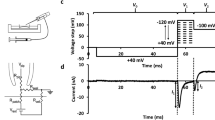Summary
In 127 skeletal muscle cells of 8 rats with alimentary potassium depletion we found a membrane potential of −92.8 (s=±6.8) mV. This value is 12.4 mV higher than the membrane potential of −80.4 (s=±6.5) mV in 150 cells of 10 control animals (p<0.001). The measurements were made in diaphragm muscles incubated in a modified Krebs-solution. The found hyperpolarisation can not be explained by change of the intra-/extracellular potassium concentrationgradient, but has to be regarded as a consequence of ionic conductivity changes of the cell membrane, possibly as a consequence of a stimulated active sodium transport (“electrogenic pump”).
Zusammenfassung
Bei insgesamt 127 Zellen von 8 Ratten mit einem alimentären Kaliummangel fanden wir mit −92,8 (s=±6,8) mV ein absolut um 12,4 mV höheres Membranpotential (p<0,001) als bei insgesamt 150 Zellen von 10 Kontrolltieren mit einem Wert von −80,4 (s=±6,5) mV. Die Untersuchungen wurden in vitro bei gleicher extracellulärer Kaliumkonzentration durchgeführt. Die gemessene Hyperpolarisation kann nicht durch eine Änderung des intraextracellulären Kaliumkonzentrationsgradienten erklärt werden. Sie muß als Folge von Änderungen der Ionenleitfähigkeit der Zellmembran angesehen werden, möglicherweise im Sinne einer Stimulierung des aktiven Natriumtransports („elektrogene Pumpe“).
Similar content being viewed by others
Literatur
Adrian, R. H., and W. H. Freygang: The potassium and chloride conductance of frog muscle membrane. J. Physiol. (Lond.) 163, 61–103 (1962).
——, and C. L. Slayman: Membrane potential and conductance during transport of sodium, potassium and rubidium in frog muscle. J. Physiol. (Lond.) 184, 970–1014 (1966).
Conway, E. J., and D. Hingerty: Relations between potassium and sodium levels in mammalian muscle and blood plasma. Biochem. J. 42, 372–376 (1947).
Cross, S. B., R. D. Keynes, and Renata Rybova: The coupling of sodium efflux and potassium influx in frog muscle. J. Physiol. (Lond.) 181, 865–880 (1965).
Cotlove, E., A. M. Holliday, R. Schwartz, and W. M. Wallace: Effect of electrolyte depletion and acid-base disturbance on muscle cations. Amer. J. Physiol. 167, 665–674 (1951).
Creese, R., N. W. Scholes, and W. J. Whalen: Resting potentials of diaphragm muscle after prolonged anoxia. J. Physiol. (Lond.) 140, 301–317 (1958).
Frumento, A. S.: Sodium pump; its electrical effects in skeletal muscle. Science 147, 1442–1443 (1965).
Führ, J., J. Kaczmarczyk u. C.-D. Krüttgen: Eine einfache colorimetrische Methode zur Inulinbestimmung für Nieren-Clearance-Untersuchungen bei Stoffwechselgesunden und Diabetikern. Klin. Wschr. 33, 729–730 (1955).
Heppel, L. A.: The electrolytes of muscle and liver in potassium depleted rats. Amer. J. Physiol. 127, 385–392 (1939).
Hodgkin, A. L., and P. Horowicz: The influence of potassium and chloride ions on the membrane potential of single muscle fibers. J. Physiol. (Lond.) 148, 127–160 (1959).
Hutter, O. F., and D. Noble: The chloride conductance of frog skeletal muscle. J. Physiol. (Lond.) 151, 89–102 (1960a).
Irvine, R. O. H., S. J. Saundners, M. D. Milne, and M. A. Crawford: Gradients of potassium and hydrogen ion in potassium-deficient voluntary muscle. Clin. Sci. 20, 1–18 (1960).
Kerkut, G. A., and R. C. Thomas: An electrongenic sodium pump in snail nerve cells. Comp. Biochem. Physiol. 14, 167–183 (1965).
Kernan, R. P.: Membrane potential changes during sodium transport in frog sartorius muscle. Nature (Lond.) 193, 986–987 (1962).
Krebs, H. A., u. K. Henseleit: Untersuchungen über die Harnstoffbildung im Tierkörper. Hoppe-Seylers Z. physiol. Chem. 210, 33 (1932).
Ling, G., and R. W. Gerard: The normal membrane potential of frog sartorius fibres. J. cell. comp. Physiol. 34, 383 (1949).
Meves, H.: Aktiver Ionentransport an Nerv und Muskel in: Transport und Funktion intracellulärer Electrolyte. München: Urban & Schwarzeberg 1967.
Relman, A. S., G. W. Gorham, and N. G. Levinsky: The relation between external potassium concentration and the electrolyte content of isolated rat muscle in the steady state. J. clin. Invest. 40, 386–393 (1961).
Zierler, K. L.: Effect of insulin on membrane potential and potassium content of rat muscle. Amer. J. Physiol. 197, 515–523 (1959).
Author information
Authors and Affiliations
Additional information
Mit Unterstützung der Deutschen Forschungsgemeinschaft.
Technische Assistenz: S. Winterling.
Rights and permissions
About this article
Cite this article
Bolte, HD., Lüderitz, B. Membranpotentiale bei experimentellem Kaliummangel. Pflügers Arch. 301, 43–49 (1968). https://doi.org/10.1007/BF00412417
Received:
Issue Date:
DOI: https://doi.org/10.1007/BF00412417




